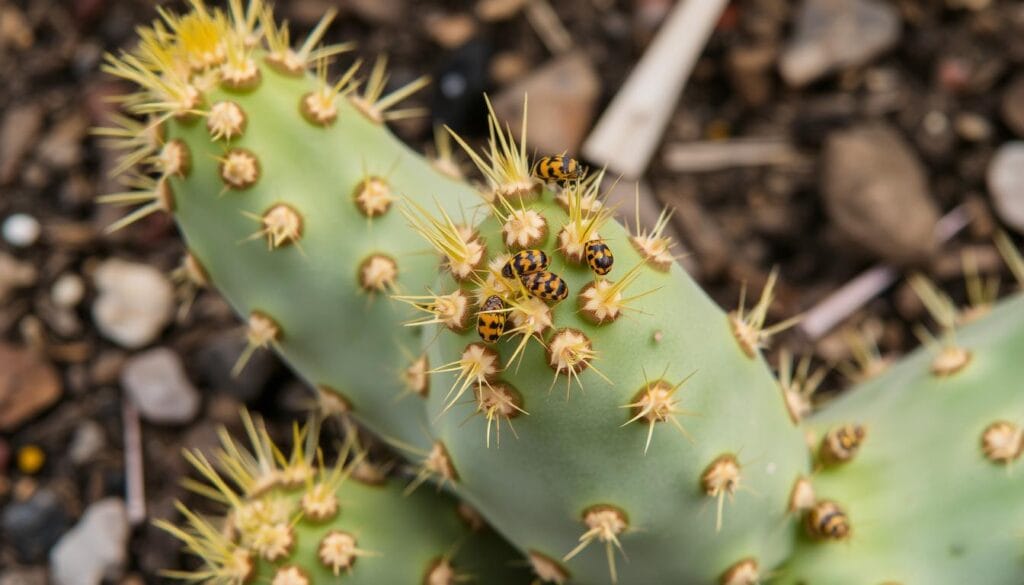Did you know the Mammillaria genus, which includes the Fishhook Cactus, has 200 recognized species and varieties1? This makes Fishhook Cacti some of the most interesting succulents for houseplant lovers.
These cacti are not just beautiful but also easy to care for. They come from the Southwestern United States, Central America, and the Caribbean. They love bright, sunny spots and need very little water2.
For the best growth, put your Fishhook Cactus about a foot from a south-facing window2. This helps them get the bright light they need. With their slow growth and low care needs, they’re great for both new and experienced plant owners.
Most Mammillaria species come from Mexico. But some also come from Colombia, Guatemala, Honduras, and Venezuela1. This wide range of origins makes each Fishhook Cactus unique.
Key Takeaways
- Fishhook Cacti belong to the Mammillaria genus with 200 recognized species
- They require minimal watering – about 0.5 cups every 12 days in a 5″ pot
- Optimal placement is less than a foot from a south-facing window
- Native to Southwestern US, Central America, and the Caribbean
- Low-maintenance and ideal for both novice and experienced plant enthusiasts
- Diverse origins contribute to fascinating variations among species
Introduction to Fishhook Cactus (Mammillaria spp.)
I’m excited to introduce you to the fascinating world of Fishhook Cactus. These spiny ornamentals are native to California and northwestern Mexico, including Baja California and Sonora3. As a cactus enthusiast, I find their unique characteristics captivating.
Native habitat and characteristics
Fishhook Cactus thrives in rocky areas. They can even grow out of granite boulder crevices in desert-edge canyons. In San Diego County, you’ll spot them on coastal sandstone bluffs, part of the Maritime Succulent Scrub3. These drought-tolerant plants are compact, usually less than 6 inches tall, with short tubercles and distinctive spines3.
Popular varieties of Mammillaria species
While there are many Mammillaria species, some standout varieties include:
- Mammillaria zeilmanniana (Rosy Pincushion Cactus)
- Mammillaria hahniana (Old Lady Cactus)
- Mammillaria elongata (Ladyfinger Cactus)
Benefits of growing Fishhook Cactus as houseplants
I love growing Fishhook Cactus as houseplants for several reasons:
| Benefit | Description |
|---|---|
| Low maintenance | Requires extremely low water; summer irrigation unnecessary once established3 |
| Adaptability | Thrives in full sun and fast-draining soil3 |
| Attractive appearance | Unique spines and winter/spring blooms add visual interest3 |
| Versatility | Suitable for containers and various plant communities3 |
These hardy desert plants make excellent additions to any indoor garden. They bring a touch of the arid landscape to your home.
Ideal Growing Conditions for Fishhook Cactus
As a fan of easy-to-care-for plants, I love the Fishhook Cactus. It’s a beautiful type of pincushion cacti. These plants need lots of sunlight, at least 6-8 hours a day, to grow well and look bright4. I put my Fishhook Cactus close to a window so it gets plenty of light5.
Watering is key for these desert plants. I give my Fishhook Cactus 0.5 cups of water every 12 days when it’s not in direct sunlight5. During the growing season, I wait until the soil is dry before watering, which is usually every 2-4 weeks4. It’s important not to water too much, as it can cause rot5.
I use a mix with perlite or vermiculite for the soil to prevent water from staying too long5. The soil should be slightly acidic to neutral, with a pH between 6.0 and 7.0, to help the plant absorb nutrients4. I only fertilize twice a year with a diluted cactus fertilizer to help it grow well4.
Fishhook Cacti do best in USDA Hardiness Zones 9-11. They’re good for both indoor and outdoor growing in warm places4. Indoors, they do well in average room temperatures and humidity.
| Care Aspect | Requirement |
|---|---|
| Light | 6-8 hours of direct sunlight daily |
| Watering | 0.5 cups every 12 days (indoor) |
| Soil pH | 6.0 – 7.0 |
| Fertilization | Twice yearly with 5-10-10 NPK ratio |
| USDA Zones | 9-11 |
By giving Fishhook Cacti the right conditions, they become great additions to any indoor cactus collection. They add beauty with little effort.
Light Requirements and Placement
When it comes to fishhook cactus (mammillaria spp.) care, light is key. These plants love bright, direct sunlight. This makes them perfect for indoor gardens.
Optimal Sunlight Exposure
South-facing windows are the best for fishhook cacti6. In the Northern Hemisphere, these windows get the most light. In the Southern Hemisphere, north-facing windows are better6. During winter, move cacti near south-facing windows for more sunlight6.
Indoor vs. Outdoor Placement
Cacti are great for indoor spaces because they’re easy to care for. But, they also do well outside, depending on the weather7. For indoor care, I turn my plants to get even sunlight and prevent them from leaning6. If it’s too dark, grow lights can help6.
| Window Orientation | Light Quality | Suitability for Fishhook Cactus |
|---|---|---|
| South-facing | Full-day sunlight | Ideal |
| East-facing | Gentle morning light | Good |
| West-facing | Intense afternoon light | May be too harsh |
| North-facing | Subdued light | Less suitable |
Protecting from Extreme Conditions
In summer, I protect my cacti from the strongest sun to avoid sunburn6. Some cacti can’t handle cold or frost, so they need protection outside7. Knowing how to place your cactus for the right amount of light ensures they grow well.
Soil and Potting Considerations
Creating the perfect home for your Fishhook Cactus starts with the right soil and pot. As a succulent gardening fan, I’ve found that these desert plants love conditions similar to their natural habitat.
Well-draining Soil Mix Recipes
I use a mix of well-draining cactus soil or sandy loam with a pH of 6.0 to 7.0. Adding perlite or coarse sand helps water drain faster. This mix prevents water from staying too long around the roots, avoiding rot8.
Importance of Proper Drainage
Good drainage is key for the Fishhook Cactus’s health. It stops root rot and fungal diseases, which can kill these tough plants. I ensure water can drain off easily to keep the roots healthy.
Choosing the Right Pot Size and Material
I choose pots with drainage holes for my plants. Raised beds are great for outdoor planting. The right soil and pot combo helps roots grow strong and plants thrive. Terracotta pots are my favorite because they let moisture evaporate through their walls.
The Mammillaria genus, which includes the Fishhook Cactus, has 139 species, each unique9. By giving your cactus the right soil and pot, you’re helping it grow well and maybe even form beautiful colonies.
Watering Techniques for Fishhook Cactus
Watering is key for cactus care, especially for the Fishhook Cactus. These plants do well with a certain watering schedule. In summer, they might need water once a week, depending on the heat10. In winter, I water them once a month or less, as they are dormant10.
Fishhook cacti love dry, arid conditions and are great for areas with little water11. I use well-draining soil to avoid waterlogged roots11. Too much water can harm the cactus, so I wait for the soil to dry before watering again10.
Terracotta pots are perfect for Fishhook Cacti as they help remove excess moisture10. Yellowing leaves and a soft texture mean too much water10. On the other hand, shriveled leaves and dry soil mean they need more water10.
Watering needs change with sunlight, humidity, and temperature. More sunlight means more water, while high humidity means less10. These plants love hot, dry places with lots of sunlight, making them ideal for outdoor spaces in warm areas11.
“Water is life, but for a cactus, too much of it can be death.”
By using these watering tips, your Fishhook Cactus will stay healthy and easy to care for, both indoors and outdoors.
Fertilizing and Nutrient Management
Proper fertilization is key in succulent gardening, especially for pincushion cacti like the Fishhook Cactus. These plants don’t need much to thrive. But a little boost can make a big difference in houseplant cultivation.
Types of Fertilizers for Mammillaria Species
When it comes to feeding Fishhook Cacti, I prefer using a balanced, diluted fertilizer. A 10-10-10 NPK mix works wonders for these prickly beauties. Some gardeners swear by cactus-specific formulas, but I’ve had success with general-purpose options too.
| Fertilizer Type | NPK Ratio | Best For |
|---|---|---|
| Balanced | 10-10-10 | General use |
| Cactus-specific | 2-7-7 | Bloom promotion |
| Organic | 5-5-5 | Slow release |
Frequency and Timing of Fertilization
I fertilize my Fishhook Cacti every 4-6 weeks during their active growing season. This is usually spring and summer. They bloom from spring to early summer, producing charming flowers in white, pink, or yellow12. It’s crucial to avoid fertilizing during their dormant period in winter.
Signs of Nutrient Issues
Keeping an eye on your cacti is essential. Slow growth or discoloration might indicate a nutrient deficiency. On the flip side, burnt tips or stunted growth could mean you’re overdoing it with the fertilizer. I’ve learned that regular repotting with fresh soil often provides sufficient nutrients without the need for frequent fertilization.

In my decade-long journey of collecting and growing cacti, I’ve amassed a collection of 25 pots with around 23 species13. This experience has taught me that each plant, including the Fishhook Cactus, has unique needs. By carefully observing and adjusting your fertilization routine, you’ll soon master the art of nurturing these fascinating desert plants.
“The key to successful cactus care is not in how much you give, but in how well you observe and respond to their needs.”
Propagation Methods for Fishhook Cactus
Fishhook cactus (Mammillaria spp.) propagation is a fun way to grow your succulent collection. Offsets and stem cuttings are the top methods for these cute cacti14.
The Mammillaria genus has about 200 species, mostly from Mexico. Some also grow in the Caribbean, Colombia, southwest United States, Guatemala, Venezuela, and Honduras15. This variety makes houseplant cultivation exciting.
For stem cuttings, I let the cut end dry for a few days. This prevents rot and boosts success14. I use a well-draining soil mix with perlite or vermiculite to avoid water pooling14.
After propagation, I keep young fishhook cacti at room temperature and water them sparingly. Overwatering is a big risk, so I let the soil dry completely between waterings14. Patience is key – these little guys grow slowly, but regular check-ins help me adjust care as needed14.
“Propagating fishhook cacti is like watching tiny desert miracles unfold in your home.”
For more advanced propagation, tissue culture is an option. It’s great for commercial-scale growth and disease-free plants. This method involves specific steps and controlled conditions, including special culture mediums and lighting15.
| Propagation Method | Difficulty Level | Time to Establish |
|---|---|---|
| Offsets | Easy | 2-4 weeks |
| Stem Cuttings | Moderate | 3-6 weeks |
| Tissue Culture | Advanced | Several months |
Whether you’re a beginner or an experienced grower, propagating fishhook cacti can be rewarding. With proper care and patience, you’ll soon have a thriving collection of these charming plants.
Common Pests and Diseases
Growing cacti indoors can be very rewarding. But, it’s important to know about common problems. I’ll talk about issues that might affect your Fishhook Cactus and other indoor cacti.
Identifying Common Cactus Pests
Managing pests is key in cactus care. Scale insects, mealybugs, and spider mites are common pests. They can harm your plants quickly. It’s crucial to check your plants often to catch and stop these pests early.

Preventing and Treating Fungal Infections
Fungal infections are a big problem for houseplants. Too much water can cause root rot and stem splitting in cacti16. Make sure your plants drain well and don’t get too wet. If you see color changes or soft spots, act fast.
Natural and Chemical Control Methods
I usually start with natural pest control. Neem oil and insecticidal soap work well against many pests. For fungal issues, better air flow and the right watering can help a lot. If needed, use chemical treatments but follow the instructions carefully.
| Issue | Symptoms | Treatment |
|---|---|---|
| Mealybugs | White, cottony masses | Rubbing alcohol, neem oil |
| Root Rot | Soft, discolored base | Reduce watering, repot in dry soil |
| Sunburn | Brown scars on exposed areas | Gradual light exposure |
Prevention is always better than cure for indoor cacti. Keep your growing conditions right and watch your plants closely. This way, you can enjoy healthy, thriving cacti at home.
Seasonal Care and Maintenance
Caring for Fishhook Cactus (Mammillaria spp.) changes with the seasons. These plants can live over 20 years with the right care, making them great for easy-to-care-for gardens17. In spring and summer, I water and fertilize more because the cactus grows faster in warmer weather17. I use a balanced, diluted fertilizer during this time to help them grow17.
In fall, I start to water less to help the cactus get ready for its sleep period. During winter, I water even less and keep it safe from frost. This helps the cactus save energy, just like it does in nature17. It’s also important to use soil that drains well to keep the cactus healthy and growing strong17.
All year, I watch for pests and diseases. Healthy cacti have bright, firm skin. If the skin looks dull or the plant wilts, it might be stressed17. Some Mammillaria species need very little water once they’re settled, which is great for gardens that don’t get much water18. By knowing what they need each season, I make sure my Fishhook Cactus is happy and beautiful in my garden.
FAQ
What are the native habitat and characteristics of Fishhook Cactus?
What are some popular varieties of Mammillaria species?
Why are Fishhook Cacti suitable as houseplants?
What are the ideal growing conditions for Fishhook Cactus?
How much light does Fishhook Cactus need?
What type of soil is best for Fishhook Cactus?
How often should I water my Fishhook Cactus?
How do I fertilize my Fishhook Cactus?
How can I propagate Fishhook Cactus?
What are some common pests and diseases affecting Fishhook Cactus?
How do I care for my Fishhook Cactus during different seasons?
Source Links
- Mammillaria
- Common Fishhook Cactus: How Much Water & Light Does it Need to Thrive?
- Fish Hook Cactus
- 7 Essential Outdoor Common Fishhook Cactus Care Routines 🎣
- Common Fishhook Cactus Care 101: Water, Light & Growing Tips
- 🌞 Is Direct Sunlight Good for My Common Fishhook Cactus?
- How to Grow Cacti Outdoors
- How to Grow Cacti Outdoors
- Mammillaria rhodantha (Rainbow Pincushion)
- How Much Should I Water My Common Fishhook Cactus? 🌵
- How to Grow Cacti Outdoors
- 33 Best Popular Types of Cactus You Can Grow at Home
- Cactus Talk & Update
- 🌵 How Do I Propagate My Common Fishhook Cactus?
- How to Tissue Culture Mammillaria elongata? – Plant Cell Technology
- Cacti Care – Pests and Diseases On-line Guide to the positive identification of Members of the Cactus Family
- 🌵 Common Fishhook Cactus Is a Perennial
- Palm springs


